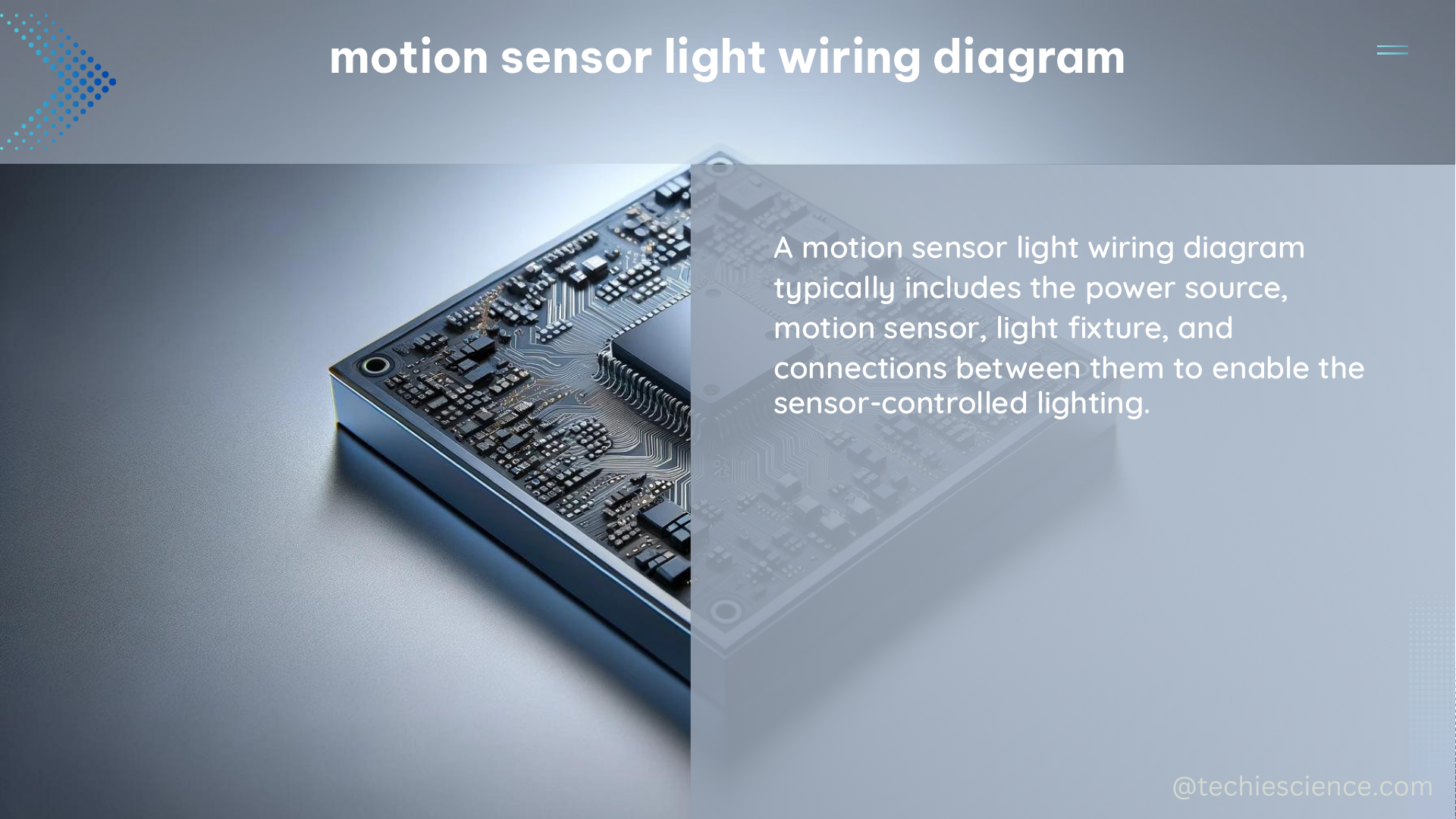The motion sensor light wiring diagram typically consists of three main components: the power source, the motion detector switch, and the bulb or load. The power source is usually the household electric, which has three wires: a bare copper ground wire, a white neutral wire, and a black hot wire. The motion detector switch, which is in itself a switch that closes when motion is sensed and opens some preset time after motion is last sensed, has three wires: a neutral (white), a hot (black), and a red switched leg/lead/wire.
Understanding the Power Source
The power source for a motion sensor light is typically the household electric, which has three main wires:
- Ground Wire: A bare copper wire that provides a safe path for electrical current to flow in the event of a short circuit or other electrical fault.
- Neutral Wire: A white wire that completes the electrical circuit and allows current to flow back to the power source.
- Hot Wire: A black wire that carries the electrical current from the power source to the load (in this case, the motion sensor and the light fixture).
The ground wire is essential for safety, as it ensures that any stray electrical current is safely diverted away from the user or the surrounding environment.
Connecting the Motion Detector Switch

The motion detector switch is the heart of the system, as it senses movement and triggers the light to turn on. This switch has three main wires:
- Neutral (White) Wire: This wire connects the neutral wire from the power source to the neutral legs of each socket.
- Hot (Black) Wire: This wire connects the black hot wire from the power source directly to the motion sensor, and only to the motion sensor.
- Switched Leg/Lead/Wire (Red): This wire carries the switched power from the motion sensor to the light fixture, turning the lights on when motion is detected.
The motion sensor switch acts as a relay, closing the circuit and allowing power to flow to the light fixture when motion is detected, and then opening the circuit and cutting power to the light fixture after a preset time delay.
Connecting the Bulb or Load
The bulb or load, which is the light fixture in this case, receives power from the motion sensor switch. When the motion sensor switch closes the circuit, the bulb or load is energized and the light turns on. The specific wiring connections for the bulb or load will depend on the type of fixture and the number of lights involved.
Single Pole Applications
For single pole applications, the motion sensor wiring diagram follows a specific configuration:
- Sensor Black Wire: Connects to the hot wire (black) in the wallbox.
- Sensor Red Wire: Connects to the wire that goes to the light fixture.
- Sensor White Wire: Connects to the neutral wire (white) in the wallbox.
- Sensor Blue Wire: Is not used and should be capped off with a wire nut.
- Sensor Green Wire: Connects to the ground wire in the wallbox.
This wiring configuration ensures that the motion sensor can properly control the power to the light fixture, turning it on when motion is detected and off after a preset time delay.
Capacitive Accelerometers in Motion Sensors
Capacitive accelerometers are one of the most widely used solid-state motion sensors on the market. These sensors work by detecting the relative displacement between a proof mass and a supporting frame, which is derived from the change in electrical capacitance.
When the movable electrode plate in the capacitive accelerometer displaces either in-plane or out-of-plane with the stationary supporting frame, the change in electrical capacitance is measured and used to determine the motion of the object. This technology is highly sensitive and accurate, making it a popular choice for motion detection in a variety of applications, including motion sensor lights.
The specific technical details of capacitive accelerometers, such as their sensitivity, range, and resolution, can vary depending on the manufacturer and the intended use case. However, the underlying principle of using changes in electrical capacitance to detect motion remains the same.
Conclusion
The motion sensor light wiring diagram is a crucial component of any motion-activated lighting system. By understanding the power source, the motion detector switch, and the bulb or load, you can properly wire and install a motion sensor light that reliably turns on when motion is detected and off after a preset time delay. Additionally, the use of capacitive accelerometers in motion sensors provides a highly sensitive and accurate way to detect movement, making them a popular choice for this application.
References:
– Wiring a Sensor Light Circuit With a 4-way Switch
– Motion Sensor Light Switch Wiring
– Capacitive Accelerometers: Principle and Modeling
– Sensor System
– Motion Sensor Integrated Light Wiring Diagram

The lambdageeks.com Core SME Team is a group of experienced subject matter experts from diverse scientific and technical fields including Physics, Chemistry, Technology,Electronics & Electrical Engineering, Automotive, Mechanical Engineering. Our team collaborates to create high-quality, well-researched articles on a wide range of science and technology topics for the lambdageeks.com website.
All Our Senior SME are having more than 7 Years of experience in the respective fields . They are either Working Industry Professionals or assocaited With different Universities. Refer Our Authors Page to get to know About our Core SMEs.